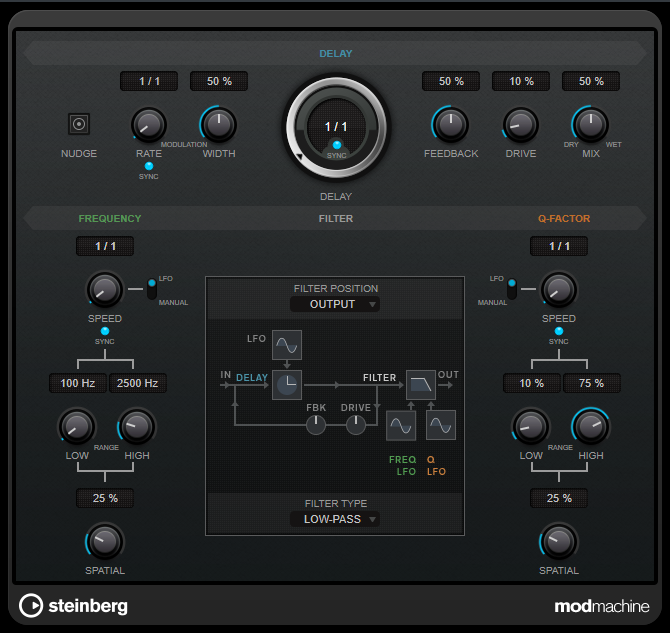ModMachine
ModMachine combines delay modulation and filter modulation. Frequency and resonance of the filter are modulated by an LFO or can be set manually. An additional Drive parameter allows for distortion effects.

Delay
- Nudge
-
Clicking this button once momentarily speeds up the audio coming into the plug-in, simulating the nudge command of analog tape machines.
- Rate
-
If Tempo Sync is activated, Rate allows you to specify the base note value for tempo-syncing the effect (1/1 to 1/32, straight, triplet, or dotted).
If Tempo Sync is deactivated, the modulation speed can be set freely with the Rate dial.
- Tempo Sync (Delay Modulation)
-
Activates/Deactivates tempo synchronization for the Rate parameter.
- Width
-
Sets the amount of delay modulation. This allows you to create a vibrato or chorus-like effect.
- Delay
If Sync is activated, this sets the base note value for the delay. If Sync is deactivated, the delay time can be set freely in milliseconds.
- Tempo Sync (Delay)
-
Activates/Deactivates tempo sync for the Delay parameter.
- Feedback
Sets the amount of the signal that is sent back into the delay input. The higher this value, the higher the number of repeats.
- Drive
-
Adds distortion to the feedback loop. The longer the feedback, the more the delay repeats are distorted over time.
- Mix
Sets the level balance between the dry signal and the wet signal. If the effect is used as a send effect, set this parameter to the maximum value, as you can control the dry/effect balance with the send level.
Graphical display
- Functional diagram
-
Shows the signal path, depending on the settings for Filter Position and Filter Type.
- Filter Position
-
Allows you to select the filter position. Loop places the filter in the feedback loop of the delay. Output places it in the output path of the effect, after the Drive and Feedback parameters.
- Filter Type
-
Allows you to select a filter type. You can choose between a Low-Pass, Band-Pass, and High-Pass filter.
Filter
- LFO/Manual (Frequency)
-
Toggles between LFO and Manual mode. In LFO mode, you can define the modulation rate or sync it to the project tempo. In Manual mode, you can set the frequency manually.
- Speed (Frequency)
-
Sets the speed of the filter frequency LFO modulation. If tempo sync is activated, this parameter sets the base note value for synchronizing the modulation to the tempo of the host application.
If tempo sync is deactivated, the speed can be set freely with the Speed knob.
- Tempo Sync (Frequency)
-
Activates/Deactivates tempo sync for the Speed parameter. This parameter is only available in LFO mode.
- Low Range/High Range (Frequency)
-
Set the range of the filter frequency modulation. These parameters are only available in LFO mode.
- Frequency
-
Sets the cutoff frequency for the filter. This parameter is only available in Manual mode.
- Spatial (Frequency)
-
Sets an offset between the channels to create a stereo panorama effect for the filter frequency modulation. Turn clockwise for a more pronounced stereo effect.
- LFO/Manual (Q-Factor)
-
Toggles between LFO and Manual mode. In LFO mode, you can define the modulation rate or sync it to the project tempo. In Manual mode, you can set the resonance manually.
- Speed (Q-Factor)
-
Sets the speed of the filter resonance LFO modulation. If tempo sync is activated, this parameter sets the base note value for tempo syncing the modulation.
If tempo sync is deactivated, the speed can be set freely with the Speed knob.
- Tempo Sync (Q-Factor)
-
Activates/Deactivates tempo sync for the Speed parameter.
- Low Range/High Range (Q-Factor)
-
Set the range of the filter resonance modulation. These parameters are only available in LFO mode.
- Q-Factor
-
Sets the resonance of the filter. This parameter is only available in Manual mode.
- Spatial (Q-Factor)
-
Sets an offset between the channels to create a stereo panorama effect for the filter resonance modulation. Turn clockwise for a more pronounced stereo effect.